-
Posts
2,316 -
Joined
-
Last visited
Content Type
Profiles
Forums
Gallery
Events
Posts posted by Dr PR
-
-
Are you using the same taler for the full length of the mast? A long tapered cone?
From what I have read the mast is more like a long half oval, tapered more on a curve than a straight line. Widest at the deck (partners) and tapered in quarter lengths in a non-linear fashion.
Divide the length of the mast from the deck to the crosstrees into four sections. The relative diameter at each quarter is:
deck (partners) 1.0
1/4 0.984
2/4 0.933
3/4 0.857
crosstrees (hounds) 0.75
I used to use a simple taper using sandpaper for the masts when I first started building ship models (50+ years ago). But when I learned real mast weren't built this way I started using the 4/8/16 tapering method in order to get better control of the mast shape. It is a lot easier that it sounds, and produces a more accurate mast shape.
YT pointed out a problem with your method. With a disc sander the rate of material removal is proportionate to the speed of the sanding surface. The outer parts of the wheel rotate faster, and the center doesn't rotate at all for practical purposes. You can't use the entire diameter for tapering because the center doesn't do much, if anything. You can modify the process by placing a spacer to raise the work piece above the center, so the sanding surface is moving, but it will still be faster on the outside of the disk than near the center, and will be more aggressive at removing material. It will be very difficult (but not impossible) to get an accurate mast taper this way.
-
Paul,
Very nice build! When you started I hoped you would do the ship justice, and now I am pleased to see you doing such nice work.
- Keith Black and Paul Le Wol
-
 1
1
-
 1
1
-
You are not tapering the planks. The distance between the bulwarks and the keel is greater midships than it is at the bow and stern. Therefore each plank MUST be tapered proportionately, wider midships (full plank width) and tapered narrower at bow and stern. Look at the tutorials and articles about planking.
Even when the planks are tapered they must be twisted/bent so they lie flat on each bulkhead/frame. There are many suggested techniques to accomplish this bending, but most use some combination of water or alcohol and heat.
I have built a number of plank on bulkhead hulls - all single layer planking - and have found a simple and effective technique that seems easier that all the other suggested methods. I use a small planking iron (actually a quilting iron used for making quilts) and wet the planks. The steam from the heated planks carries heat into the wood and this makes it pliable. Then when it cools it holds its shape.
-
I am fortunate to have some close-up photos that show the details. The blueprints are good for showing the equipment, but they don't show the small details such as the wiring or notices/instructions attached to bulkheads. And often the equipment is different in the photos, or in the positions. For example, on the starboard interior bulkhead of the pilot house the blueprints show two AM-215/U amplifiers below the windows. However, I found the data sheet for this amplifier and the dimensions were larger than shown in the blueprints. They were too large to fit two as shown in the blueprints. And the pilot house photo shows only one, in the position I placed it in the model.
I don't have enough photos of the Cape as it was in 1969 when I was aboard. For example, I don't know what was attached to the exterior of the pilot house forward bulkhead, in the open bridge. One photo does show a phone handset cradle and a box (for a sound powered phone headset?) on the starboard side, but it doesn't show what else might be on the center or starboard side of that bulkhead, such as a speaker, light, etc. I haven't found those details in the blueprints.
While I was on the USS Oklahoma City CLG-5 I took thousands of photos. I even thought that I might someday make a model of that ship so I went around photographing almost every exterior surface, plus the bridge and pilot house. Even so, there were two places (under the port and starboard boat decks) that I did not have pictures. Those photos were invaluable for creating the CAD model as the ship was in the summer 1971. I have the 1959 blueprints, but the ship had undergone many modifications by 1971 - some pretty extreme - that weren't shown in the drawings.
Just about any photos are good. They may be of sailors working or goofing off, but in the background are details.
- Jim Lad, Coyote_6, Ras Ambrioso and 1 other
-
 4
4
-
Still working on the small details for the O1 deck house.
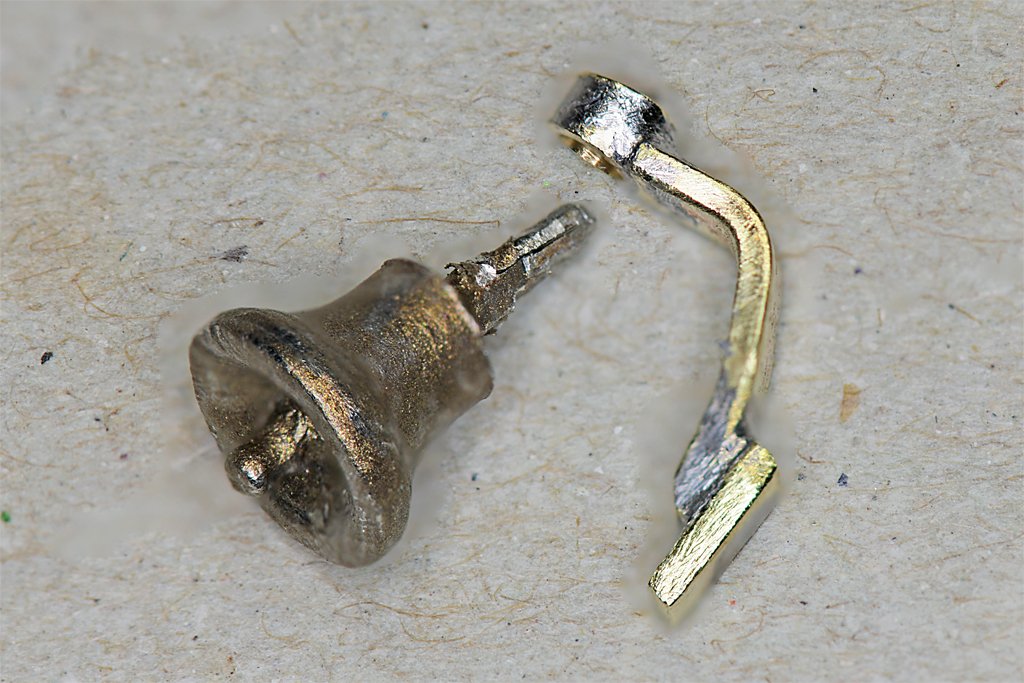
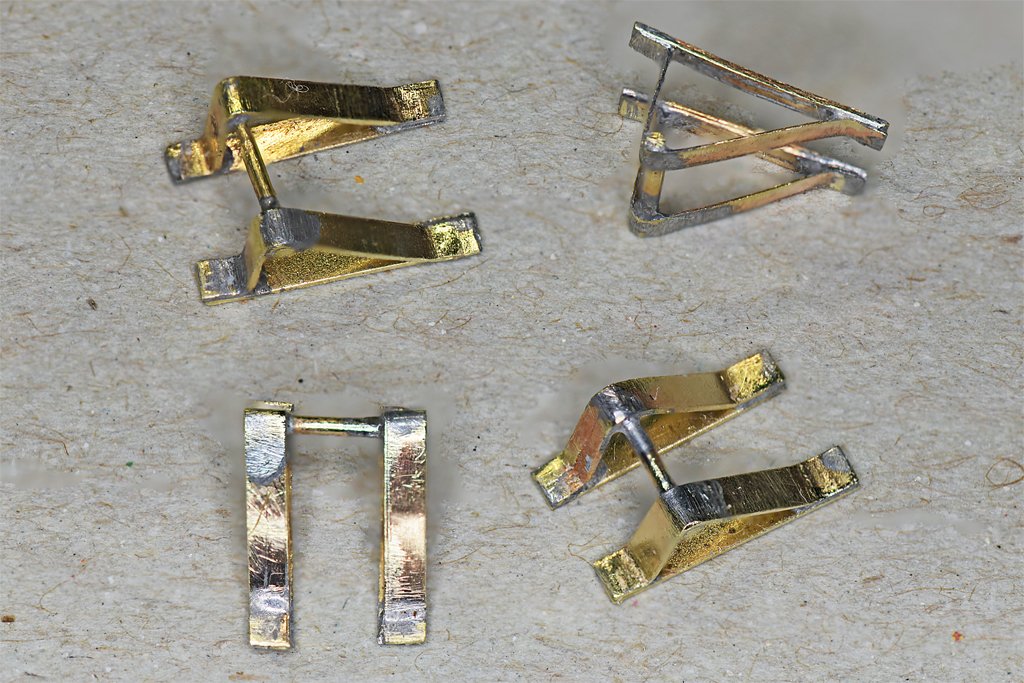
The bell bracket was made from 0.030 inch (8 mm) brass. The bell is from Bluejacket Ship Crafters (1/4 inch, part F0483). I have made bells from scratch, but it was much easier to order the bell while I was also ordering the propeller. The parts on the right are brackets to belay signal halliards.
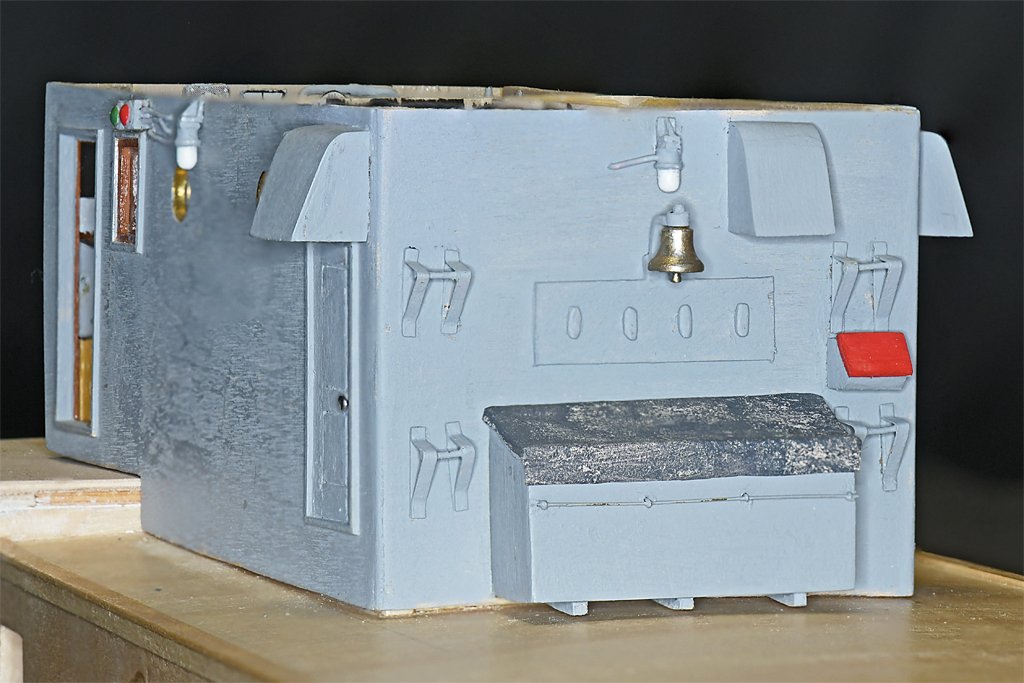
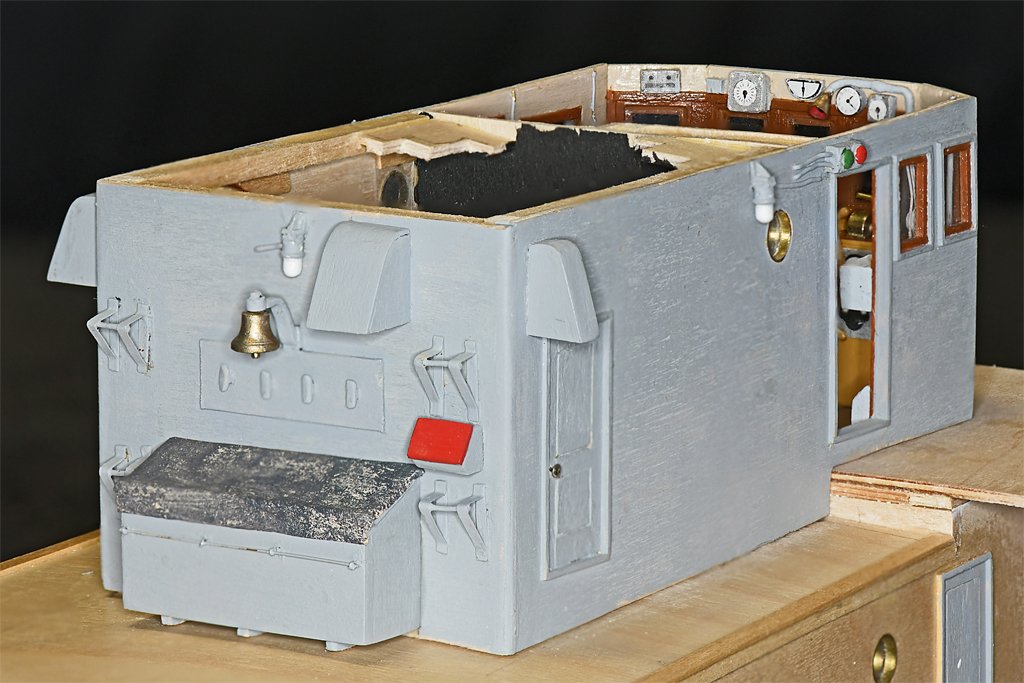
Here are a couple of photos of the signal bridge. the flag bag (flag locker) has a "canvas" cover. It was made from some of the scrap silkspan I had left over from the topsail schooner build. It was painted off-white for the schooner sails so I brushed on some Tamiya "German Grey" (XF-63). This is what I will use for the O1 and O2 level decks.
A board with cleats for securing halliards is above the flag bag, with the halliard belays on either side. The thing with the red top is the shore connection box where the ship was "plugged in" to shore power while docked. There are three vent hoods from the fan room at the aft end of the O1 level house.
-
Jim,
I am sure the open exposed bridge did give better views of what was happening. This was especially critical before radar and sonar when all eyes on watch was very important.
On the USS Oklahoma City CG/CLG-5 most of the open bridge had been enclosed, and the bulkhead between the enclosed bridge and pilot house had been removed (the USS Little Rock CG-4 museum ship still has the bulkhead between the bridge and pilot house). However, we always stepped out to the open wing of the bridge to look around before executing a turn, and all maneuvering for UNREPS was done from the open bridge wing.
Still, I would like to think standing on an open bridge with freezing water sloshing over your feet for four hours did build character!
-
It had an open bridge, but with a windshield on the bulwark and a canvas awning overhead. But it was cold and windy, and pretty wet when it rained. In heavy seas we could take water over the bulwark - once I had several inches of water sloshing back and forth on the deck, and wet feet. When it got really nasty I would step into the pilot house to warm up.
Many (most?) US Navy ships had open bridges until after WWII. I guess it was supposed to "build character" for the watch standers. In the 1950s many ships had the bridges enclosed, with open wings.
-
Here are a few more small details.
The ship had several lights on the external bulkheads to illuminate the decks at night. I had the approximate dimensions and a 3D CAD file from the Okieboat CAD model. All I needed to do was make them in styrene.

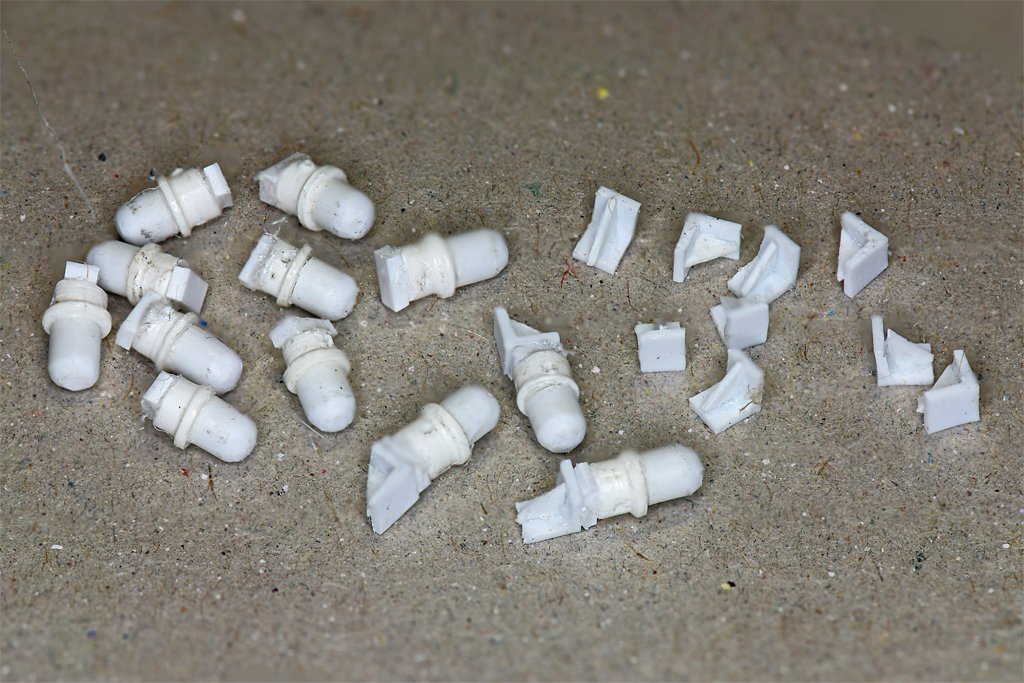
I used two sizes of styrene tubing - 0.100 and 0.125 inch (2.5 and 3.2 mm) diameter (left). I chose tubes instead of rods because they would fit concentric around a center rod and I wouldn't have to machine all of the dimensions. The base was turned and shaped with files to get the rim around the light. I didn't have the appropriate size rod so I rounded a piece of 0.0625 inch (1.7 mm) square styrene for the tubing to fit onto. After the glue set the end of the "bulb" was rounded with files and a 0.022 inch (0.6 mm) hole was drilled through the lamp base for the wiring.
The next step was to cut pieces of a 0.100 inch (2.5 mm) angle for the mounting bracket (right). A bit of 0.015 inch (0.4 mm) styrene was shaped and glued into the angle. A small piece of 0.030 x 0.060 inch (0.8 x 1.5 mm) styrene was glued to the top of the lamp assembly, and the mounting bracket was glued onto this. The pieces were painted and this finished the lamp assemblies. I know I will need six or seven of these but I made a dozen. I will choose the best for the model.
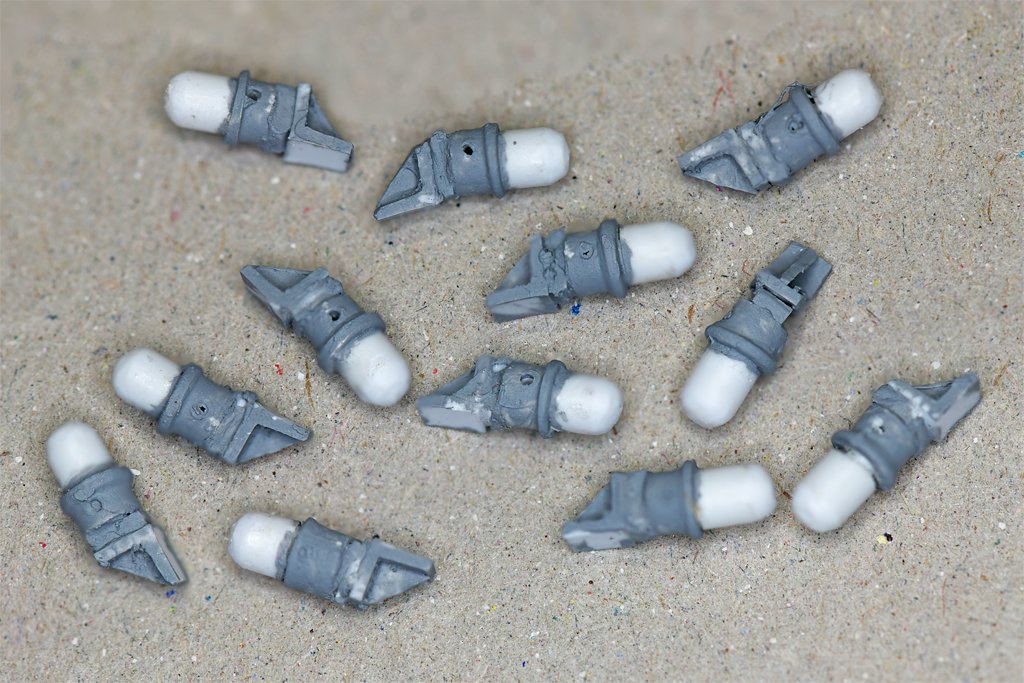
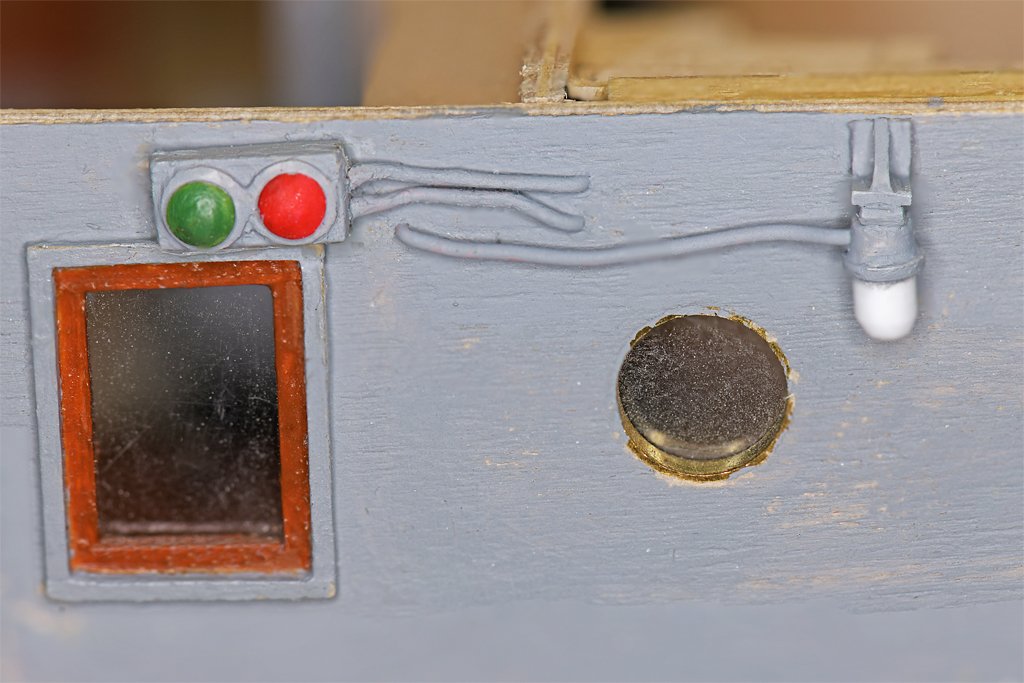
The photo on the right shows a lamp mounted on the port bulkhead of the O1 deck house behind the pilot house. A two colored Polarity Light is mounted above the window over the chart desk. The wiring for the lights is 0.020 inch (0.5 mm) copper wire. Ideally there would be a short "stuffing tube" around the wires where they enter the light housings, and another where the wires penetrate the bulkheads, but I couldn't figure a way to make these repeatably at this scale. The deck house sides have been painted with an acrylic base sealer, two coats of grey acrylic paint, and sanded. I will add another coat of paint, sand again, and finish with a clear satin acrylic varnish.
Here are a few more photos of the pilot house after the front bulkhead was attached. The compartment was 9 feet (3 meters) wide with just enough room for the helmsman at the wheel and the navigator at the chart desk and radar.
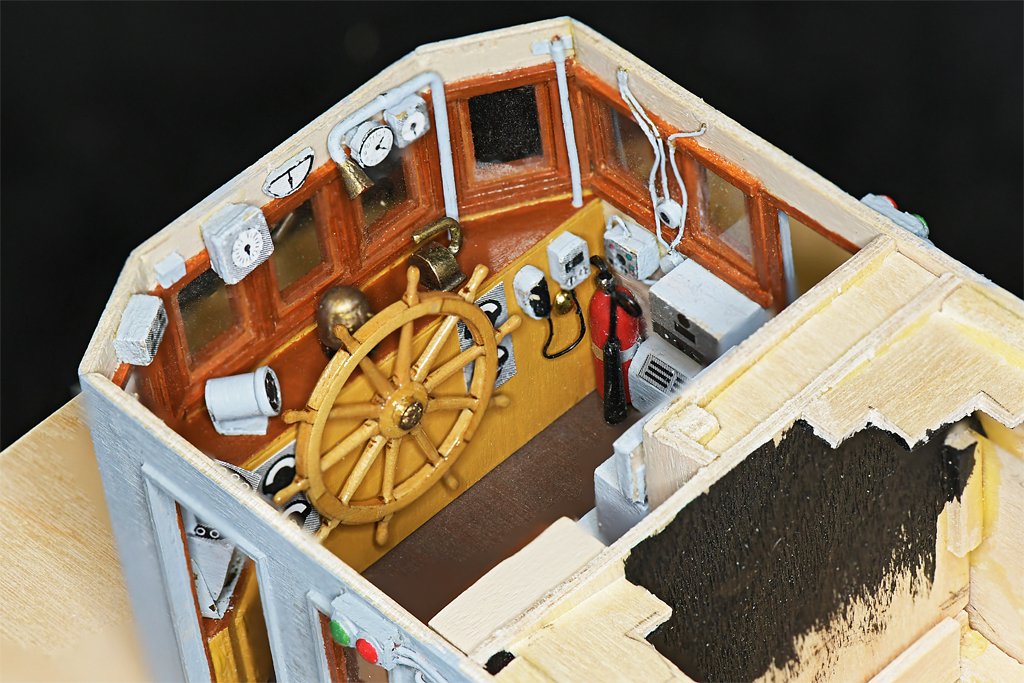

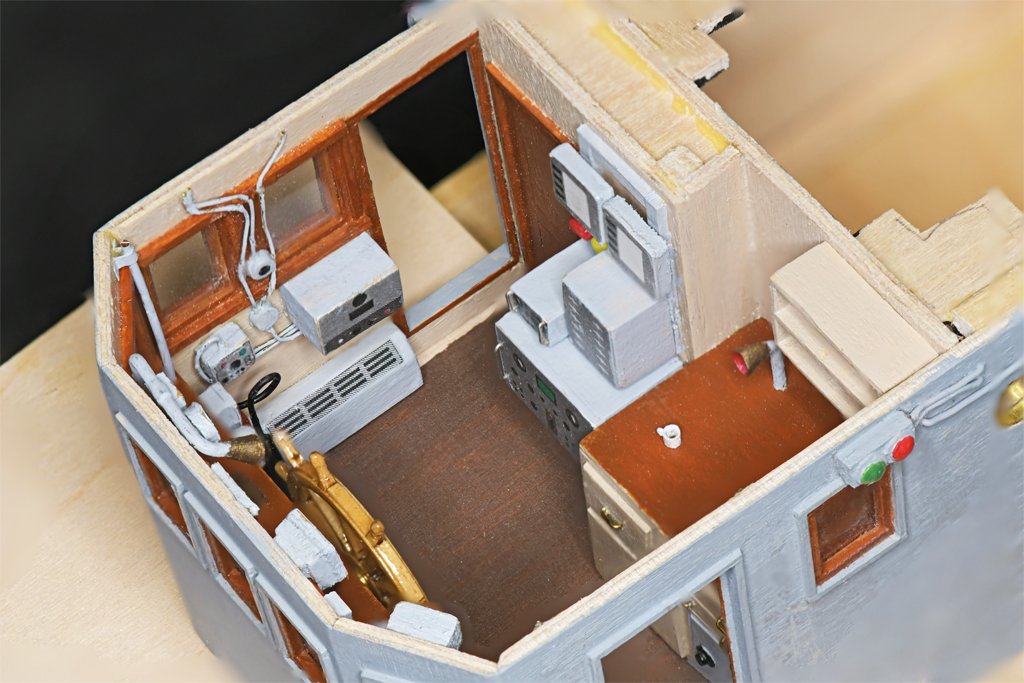
I am adding details to the exterior of the O1 level deckhouse and am about ready to put the O2 level deck over the house. This will also involve making the footing and attachments for the mast.
There are actually relatively few wiring details on the exterior of this ship. It has wooden bulkheads that were framed much like ordinary house construction, and most of the wiring was placed inside the walls. This is in contrast to metal ships with thin (3/8 inch or 10 mm) steel plate bulkheads where much of the wiring is routed externally.
There were railings around the O2 level on top of the deck house, and a few assorted odds and ends on the O2 level.
-
If you want to make a living at modeling then you need to know what the customer wants.
It seems to me that there are three types of models. One is what the builder likes. The second is an attempt at historical accuracy. The third is a product that will sell commercially. If you want to sell your models you should investigate what is selling.
Some commercial models are cheap junk intended as "souvenirs" for the average tourist who wouldn't know a ship from an elephant. Accuracy isn't important. "Pretty" is. They are for the tourist market, and are produced in large quantities.
At the other extreme are the very accurate models built to order for specific customers. These are representations of vessels in the state the customer wants them built. Look at some of Valeriy V's exquisite models for examples. These are one-off models built for a single buyer.
In between are builder's models and "Admiralty" style models intended to show the buyer of the real ships what they would look like. These tended to have lots of polished brass and varnished wood that wouldn't be seen on the real vessel.
What do you want to do?
-
Harvey,
I don't know how I have been missing this build! Nice work on a very interesting vessel.
-
Valeriy,
Beautiful work, as usual!
I like the all metal construction too. You have access to the inside surfaces and joints, and that lets you get a good strong solder joint. You can leave a bead of solder on the inside of the joint because it won't be visible from the outside.
Another problem has sometimes happened to me when I used a motor tool rotary wire brush to remove excess solder from the outside (visible) joints. I want to get clean sharp joints, but if I remove too much solder the joint is weakened and breaks easily. Leaving the solder bead on the inside keeps the joint strong.
Plexiglas (acrylic) probably wouldn't be a good choice if you are sheathing the core with soldered brass parts. Plexiglas melts easily, and who knows where it will flow. It could mess up the surfaces the brass should fit against.
It is good to see you are still well and working on the model!
-
Tom,
I would like to take credit for remembering all of that - especially the equipment model numbers - but I am working from blueprints with complete lists of everything from type and numbers of screws to the make and model of the radar. To be honest, I don't remember much of it.
You made me curious, so I looked at my DD214 and all it says was "discharged," "honorable," and "strength adjustment." The war was winding down and the Navy had too many junior officers. Basically it said "Thanks for your service, good bye, and don't let the doorknob hit you in the rear."
-
Well, it was better than swimming out with a hammer and beating on them!
- Paul Le Wol, Ras Ambrioso, Nirvana and 5 others
-
 1
1
-
 7
7
-
Thanks to everyone for your comments and likes.
Here is a bit more progress:
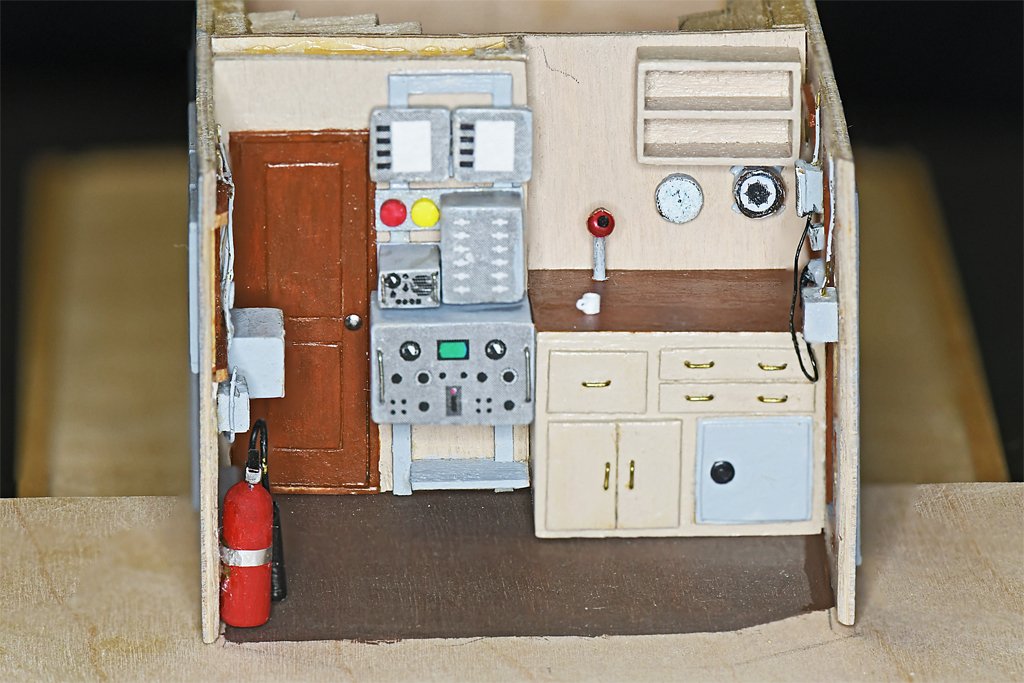
I have started assembling the O1 level superstructure.
The sides of the pilot house are attached to the after pilot house bulkhead and the after bulkhead on the deck house.
Here are a few views of the pilot house details before the forward bulkhead is attached.
The deck was covered with brown linoleum tiles. I won't try to replicate the tile lines or the random pattern - they are too small to see at this scale.
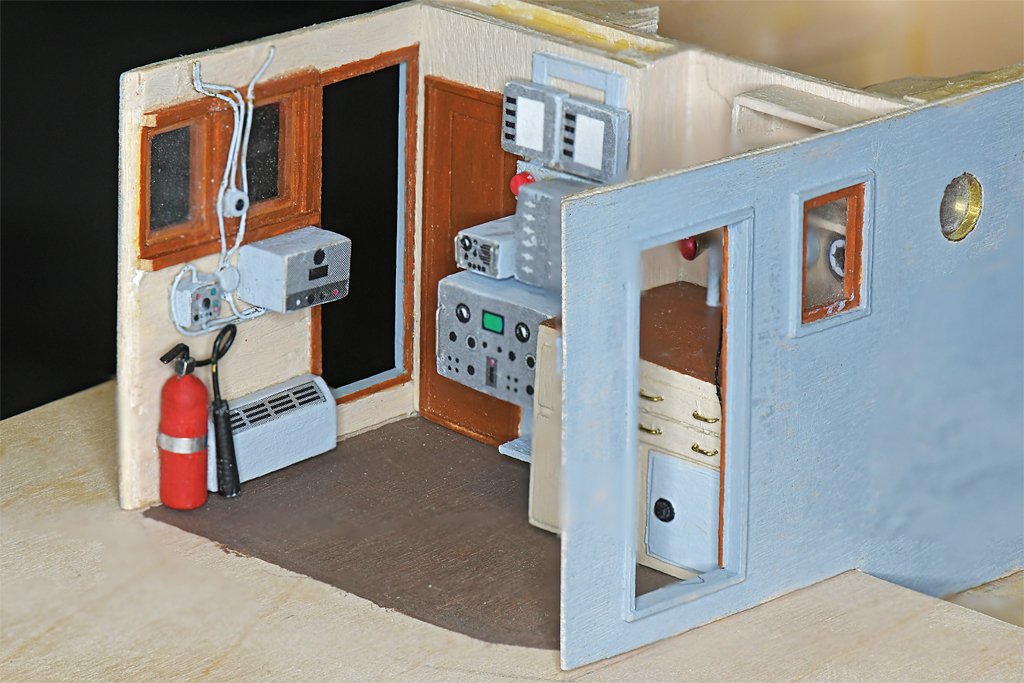
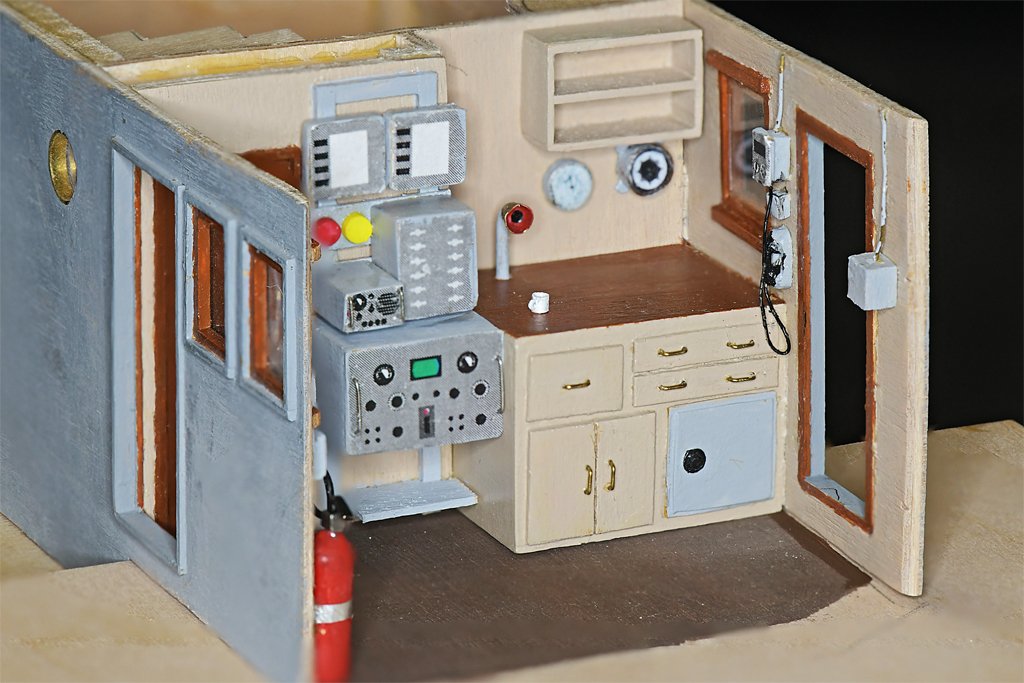
Here are a couple of photos of the deck house on the hull.
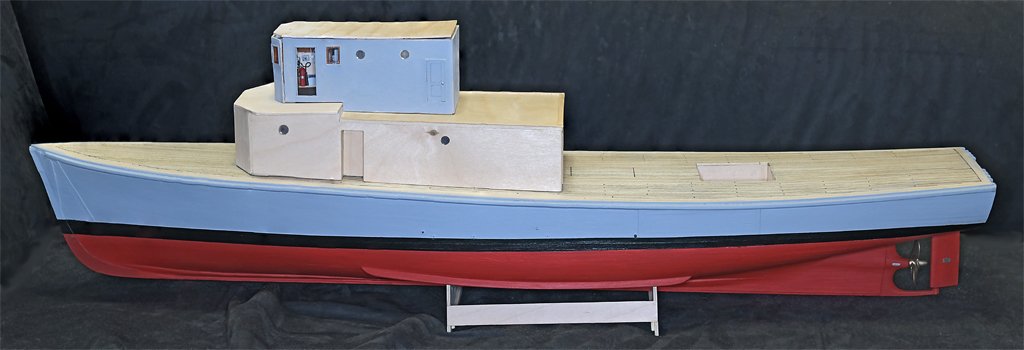

The front and top of the O1 level are not attached yet, and are just sitting there. The O1 house is not attached to the main deck level house. Likewise, the main deck level deckhouse is not glued to the hull. There are still a lot of details to add to the superstructure and it will be easier to work on the parts off the hull.
The next step will be the bulwark around the open bridge. For that I will remove the O1 level house so it isn't in the way.
You can see one of the characteristics of minesweepers - a high pilot house up forward. This helps to see mines in the water ahead. Lookouts were posted on the O2 level above the pilot house to watch for mines. They carried M1 Garand rifles, and I was stationed there with a Browning Automatic Rifle (BAR). We were to shoot at any mines we saw, primarily to mark the location for the 50 caliber machine gun crew at the bow, and so the helmsman could try to avoid the mine. If we got lucky we might even detonate the mine, or sink it. We never fired at a real mine while I was aboard.
-
The boot topping and the waterline are not the same thing.
The bottom of the boot topping is usually about the light load waterline - no fuel, ammunition or crew. Like the ship came from the shipyard before commissioning.
The top of the bott topping is about the full load waterline - maximum fuel, stores, ammunition and crew aboard. More than the normal load.
The normal operating waterline is somewhere between the light and full load, somewhere about the middle of the bott topping. Look for the draft marks to show where the normal operating water line should be.
Add to this the fact that these waterlines changed every time new equipment, guns and such were added, and it is a bit tricky figuring where to paint the boot topping on a model.
Given this, remember that ships stationed overseas often did not have the resources of a shipyard and drydock when repainting, and the resulting boot topping can be just about anywhere the crew painted it.
-
John,
The doors on the sides of the pilot house will be open, and the interior will be visible through them. The side windows will offer a bit of a view. But the front windows will be hidden under a canvas cover over the open bridge.
I suppose if you use a dental mirror or fiber optic camera you could see most of the detail.
- Ras Ambrioso, Jim Lad, Canute and 3 others
-
 6
6
-
 I needed one more detail to finish the forward bulkhead of the pilot house - a phone. The Navy used sound powered telephones (current was generated by the microphone in the handset) for internal communications because they required no external power.
I needed one more detail to finish the forward bulkhead of the pilot house - a phone. The Navy used sound powered telephones (current was generated by the microphone in the handset) for internal communications because they required no external power.
The sending and receiving unit could be an ordinary looking telephone handset or a separate microphone and earphones.
There were three handsets in the pilot house and on the bridge. I carved this one out of a 6 mm (~1/4 inch) piece of boxwood. It is pretty crude, but good enough for this use. The handset is housed in a cradle
It took about six hours to carve this one. I need two more!
You can see the handset on the right in these photos, next to the phone system call unit (hand cranked to generate the ring signal.).
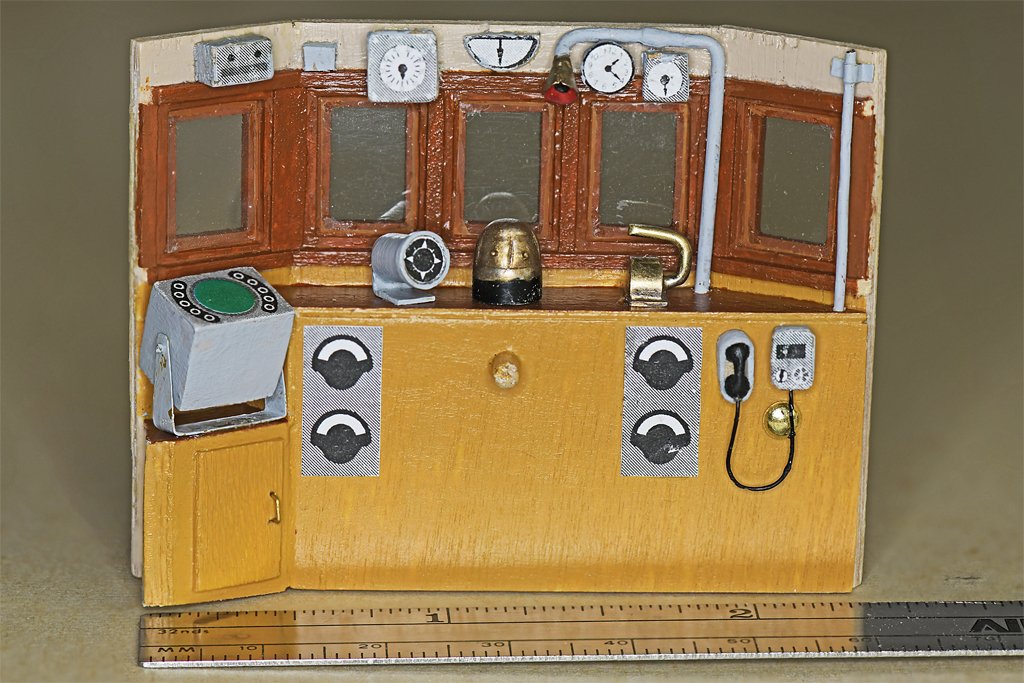
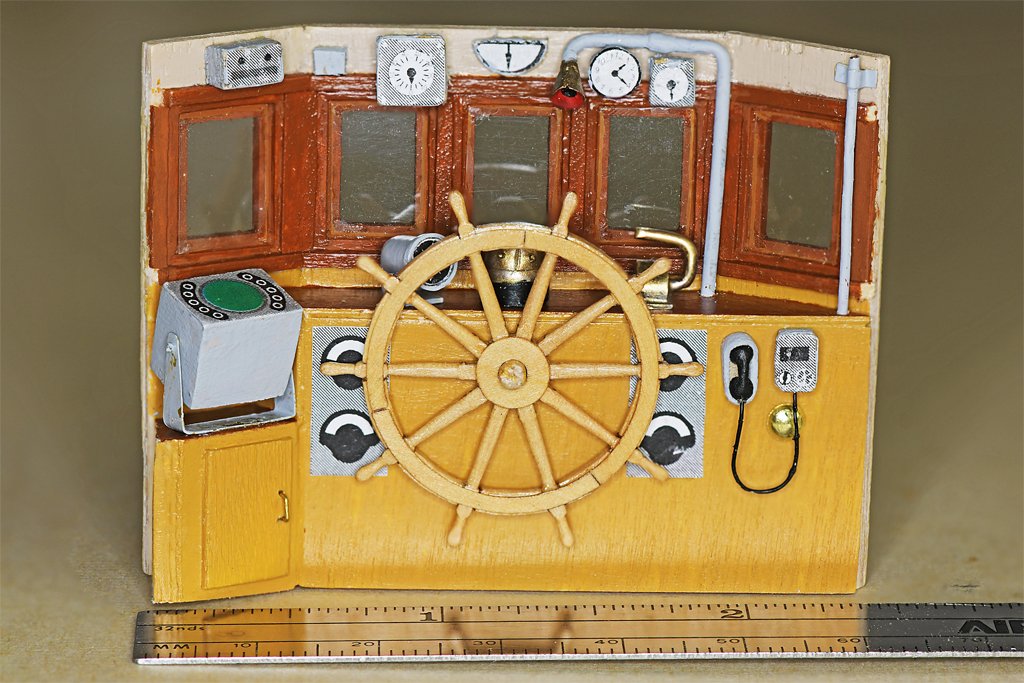
At left center is the radar unit. two pairs of tachometers for the engines flank the wheel, with the phone system to the right and a bell below the telephone call unit. On the shelf in front of the wheel are the main gyro (left), magnetic compass (binnacle, center) and the engine control (throttle) on the right. Above, from left to right, are the gyro amplifier, the small windshield wiper control, the rudder angle indicator, clinometer, voice tube, clock and propeller shaft rotation indicator.
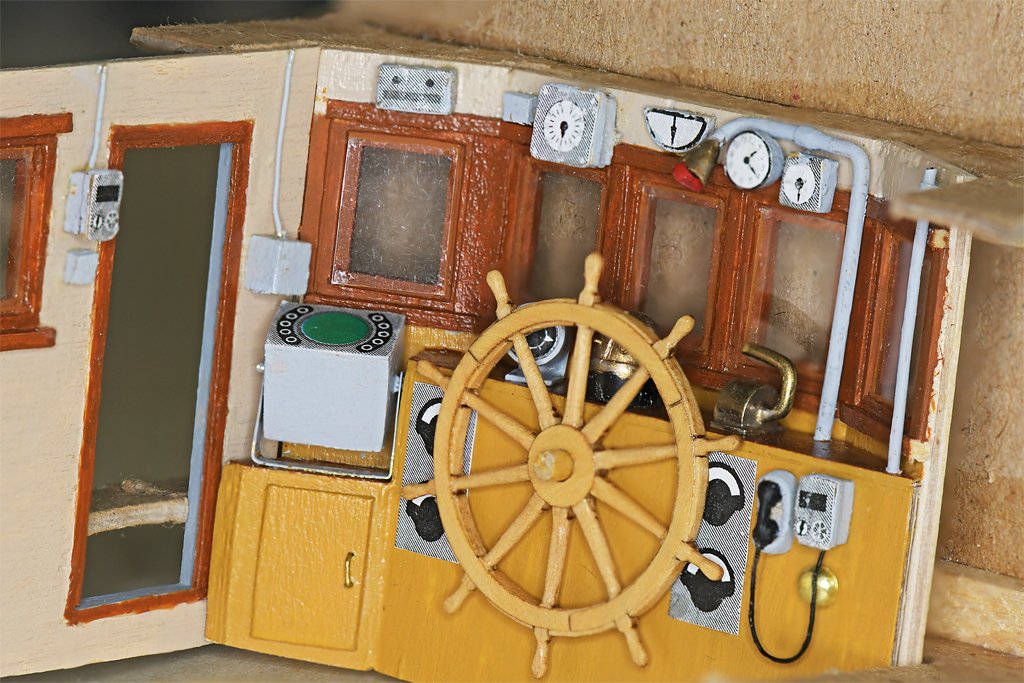
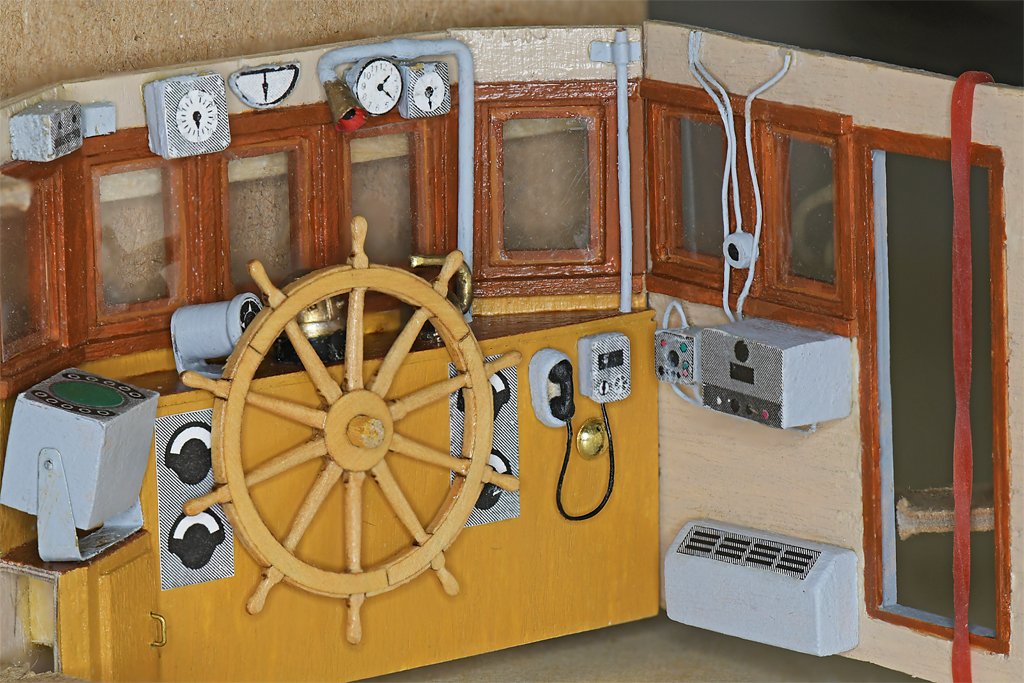
In these photos I have placed the front bulkhead and side bulkheads in the alignment jig to show how the pieces fit together. Not much is on the port bulkhead - just a sound powered phone call unit (less the handset). On the starboard bulkhead are an amplifier and control unit for the radios, and a heater. The CO2 cylinder will fit at the angle in front of the heater. The Engine Order Telegraph will be positioned on the deck beside the heater.
I suppose I could add some more wiring here and there, but it wouldn't be visible, so I guess the pilot house interior is complete - except for one more telephone handset on the port bulkhead beside the chart table.
I guess I will use the Syren 1 - 1/4 inch wheel, even though it is 25% oversized (should be 1 inch or 4 feet at full scale) and ten spokes instead of eight. No one but me will know the difference.
I will now take a break to do the taxes as Treasurer for a non-profit. That could take a few days to two weeks.
-
Steve,
Thanks!
I am printing the "faces" of the instruments on my laser (actually LED) printer, on ordinary printer paper. Then I cut them out and glue them to the instrument body. This works OK for the wooden parts. But the dial face on the EOT came out a bit the worse for wear.
I soldered all the parts together, including a pin for the EOT handle to attach to. Then the paper "dial" face was glued on. So far, so good. But when I soldered the handle onto the pin (briefly) the dial face became heated and distorted. It looks like some of the ink flaked off, so you can't read the lettering any more. It was probably the solder flux that distorted the printing.
But it will be inside the pilot house and almost invisible, so it will work OK.
- Ras Ambrioso, FriedClams, Nirvana and 5 others
-
 8
8
-
Ken,
It would be appropriate to have a Chief for the coffee mug (I don't know if I ever saw a Chief without one). However, the highest ranking enlisted man on the Cape was a 1st Class Bosun's Mate.
- FriedClams and Canute
-
 1
1
-
 1
1
-
Terry,
The wardroom tables on the USS Oklahoma City CLG-5 had smooth plastic tops covered with table cloths. The tables were supposed to be bolted down, but some had been repositioned without fastening. This wasn't a problem until we were chassed out of White Beach, Okinawa, buy a typhoon that made a sudden appearance (before weather satellites). While turning to put the wind on the starboard bow (northern hemisphere) we took some 30+ degree rolls. This was while the wardroom was seating for Sunday morning brunch.
I had been topside taking photos of the storm and had just stepped up to the wardroom door when the ship took its heaviest roll. There were crashes from one end of the ship to the other as equipment broke loose from bulkheads and furniture slid around. This is what I saw when I opened the door - breakfasts and broken dishes on the floor and people and furniture sliding around on spilled sugar and cereal.

The South China Sea and Gulf of Tonkin were hit by a series of storms that lasted a month and a half. We rode through five typhoons and a tropical storm in three weeks (and dodged two others)! After Okinawa we gave up and went to Yokosuka, Japan, for repairs.
-
More fiddly bits.
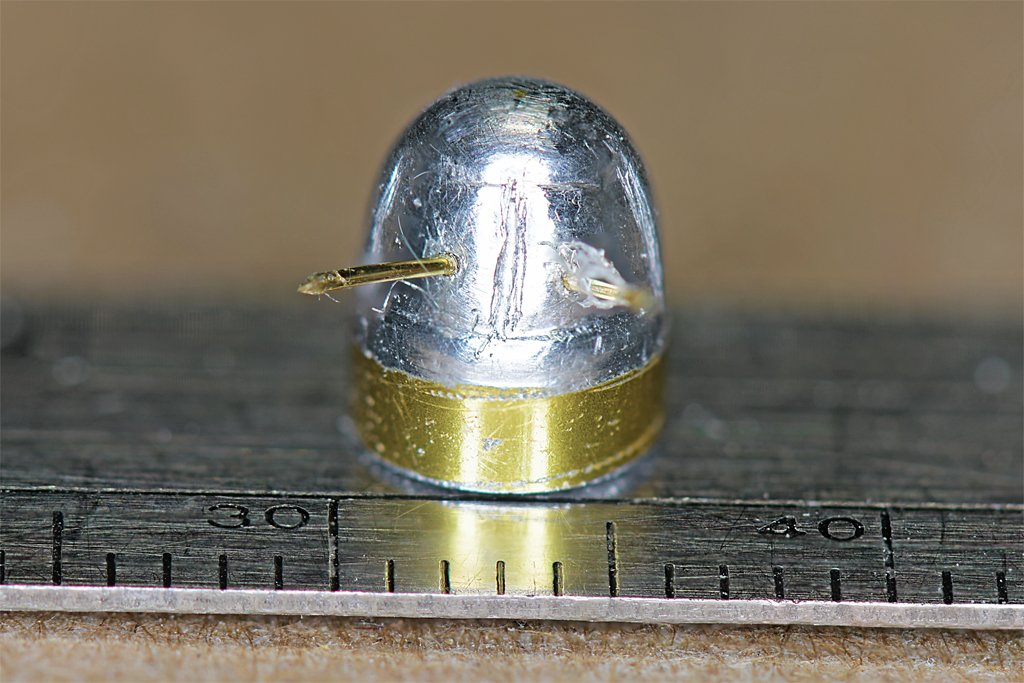

The binnacle was turned out of a piece of 1/4 inch (5 mm) aluminum rod - part of a small wind chime (I didn't have a brass rod the proper diameter). The dome was shaped using a hand drill and files. The binnacle on the ship had two sliding doors that closed in front of the compass rose. To simulate this I carved the aluminum with a #11 blade and a tiny chisel made from a dentist's tool. It was a slow process! The two thin brass rods sticking out were for the two knobs.
On the right the binnacle is in position in front of then helm. It was painted with the brushed bronze paint I used on the propeller. A few other small details can be seen. The voice tube from the bridge hangs over the helm station. The tachometers for the engines are on either side of the helm, and a sound powered phone call station is at the lower right. A phone hand set and a few more pieces will be added beside the binnacle and above the windows.

Here is the lee helm or Engine Order Telegraph (EOT). It is made from 11 different pieces. It is 1.14 inches (29 mm) high from the base to the top of the handle (a bronze belaying pin). That is 4 feet 6 inches (1.4 meters) at 1:1 scale.
I buffed it up good and then applied a layer of clear acrylic varnish to keep the shine. However, it appears the varnish may have reacted with the brass, and it is a lot duller a day later!
I don't know if the EOT was ever used. The ship had a throttle beside the binnacle that the helmsman could use to control the engines. However, I do recall using standard engine orders - Ahead/Back 1/3, 2/3 and Full - when pulling away from the pier, so maybe it was normally used. The throttle might have been used to change propeller speed a few RPM in station keeping while sweeping mines.
The 6 inch (150 mm) 15# CO2 bottle was turned from a 0.185 inch (4.7 mm) brass rod. The cone is styrene rod.
I still have 14 more pieces to go on the forward bulkhead and side bulkheads of the pilot house.
-
The weather (windward or upwind side) backstays are tightened to take the strain on the mast.
The lee (downwind side) backstays are slackened, and the tackle is moved, to allow the boom to swing outboard.
As Trevor said, when the boat gybes (changes course so the wind comes from another side) and tacks while running into the wind (changing course so the wind is coming from ahead on another side on the bow) the running backstays have to be adjusted to support the masts from the windward side. It keeps the crew busy when course changes are frequent.
-
-
I don't recall mugs without handles, so that must have been before my time.
If I was working in 1:24 the model would be 4' 6" long (1.4 meters). As it is, at 1:48 it is 28 inches (711 mm) long and pretty large.
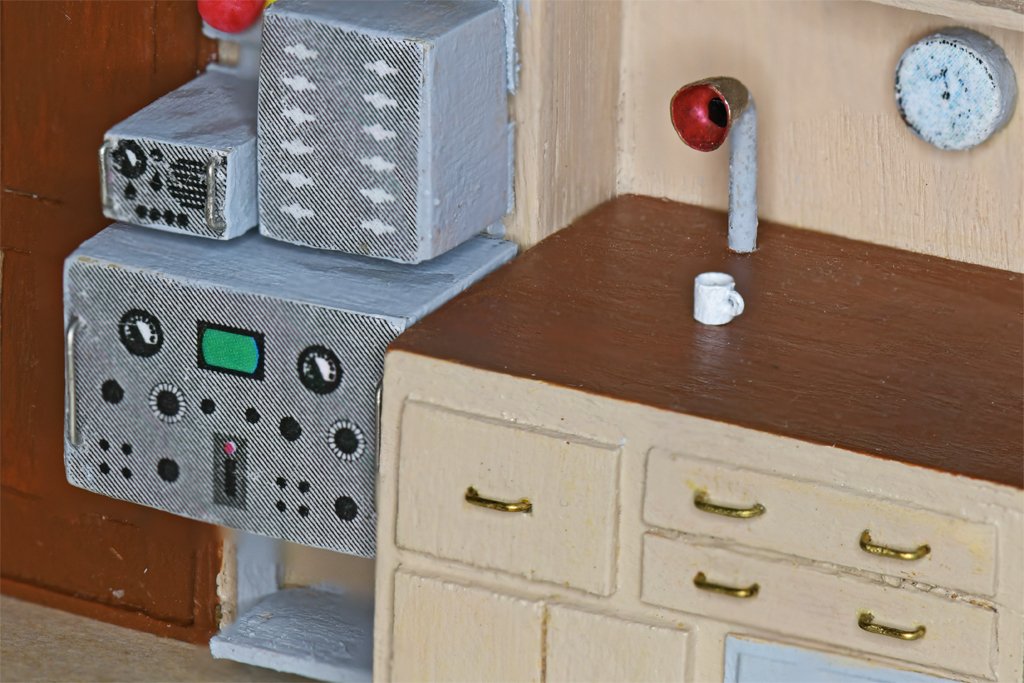
And I must confess, I didn't paint the Navy seal on the mug - that picture was a Photoshopped fake.
Here is the real 1:48 coffee cup on the chart desk.
- Knocklouder, yvesvidal, Jim Lad and 6 others
-
 9
9





Staghound 1850 by rwiederrich - 1/96 - Extreme Clipper
in - Build logs for subjects built 1851 - 1900
Posted
Nice work!